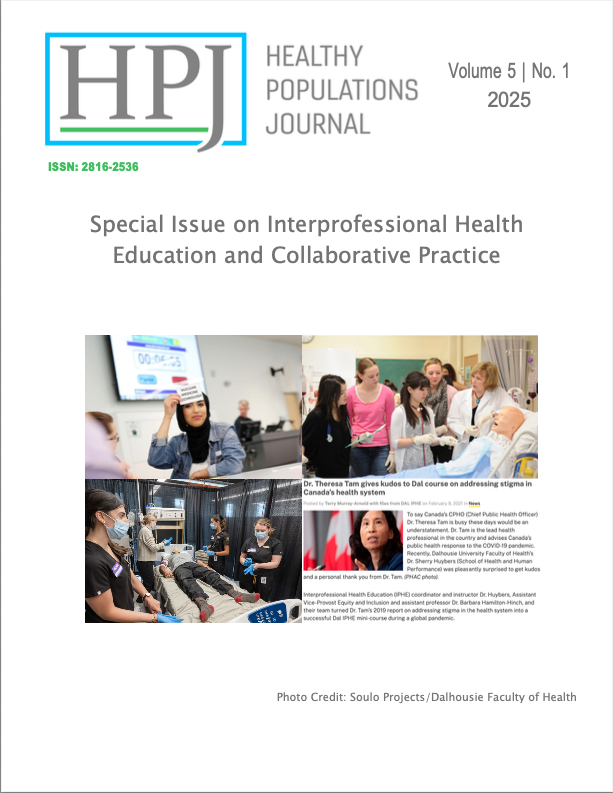Use of an Infographic to Understand Barriers to Diabetes Care for People with Lived Experience of Homelessness in Shelters and Increase Diabetes Awareness Among Shelter Staff and Interprofessional Health Teams
DOI:
https://doi.org/10.15273/hpj.v5i1.12238Keywords:
Diabetes, Homelessness, Community-Based, Health EducationAbstract
Introduction/Objective: Diabetes mellitus is a chronic medical condition that is considered to be a global health emergency (International Diabetes Federation, 2021). Managing diabetes is challenging and requires a multi-disciplinary approach while also demanding a significant degree of patient engagement and self-management. People with lived experience of homelessness (PWLEH) universally face barriers to accessing diabetes care, engaging in self-management and are consequently more likely to have chronic hyperglycemia (Hwang et al., 2000) and adverse outcomes (Sharan et al., 2023). A study discovered that PWLEH and diabetes experience myriad unique barriers to diabetes self-management in shelters (Grewal et al., 2021). A community- based prioritization exercise identified that this group’s main priority was to increase the diabetes-related knowledge and awareness of those living and working in emergency shelters. We sought to co-create an infographic with PWLEH to address some of this knowledge and understanding gaps for those in the sector. Methods: The infographic was created through a focus group discussion with PWLEH and diabetes, with consultation from clinical experts. The infographic addresses identified knowledge gaps by presenting accessible and user-friendly information about diabetes, including its definition and general management principles such as blood glucose monitoring and insulin administration. We also outline key symptoms and management principles of hypoglycemia and hyperglycemia and highlight that both conditions can mimic intoxication. Conclusion: The infographic will be disseminated in shelters with a goal of increasing knowledge regarding diabetes and its management among shelter staff with the hopes of improving the experiences of those living with the condition in shelters. This will foster education among and between interprofessional healthcare providers working in shelters and community health centres, and frontline shelter staff who are involved in the care of people with diabetes. We also aim to evaluate its efficacy in achieving this outcome.
References
Grewal, E. K., Campbell, R. B., Booth, G. L., McBrien, K. A., Hwang, S. W., O'Campo, P., & Campbell, D. J. T. (2021). Using concept mapping to prioritize barriers to diabetes care and self-management for those who experience homelessness. International journal for equity in health, 20(1)
Hwang, S. W., & Bugeja, A. L. (2000). Barriers to appropriate diabetes management among homeless people in Toronto. CMAJ : Canadian Medical Association journal = journal de l'Association medicale canadienne, 163(2), 161–165.
International Diabetes Federation. IDF Diabetes Atlas, 10th edn. Brussels, Belgium: 2021. Available at: https://www.diabetesatlas.org51
Sharan, R., Wiens, K., Ronksley, P. E., Hwang, S. W., Booth, G. L., Austin, P. C., Spackman, E., Bai, L., & Campbell, D. J. T. (2023). The Association of Homelessness With Rates of Diabetes Complications: A Population-Based Cohort Study. Diabetes care, 46(8), 1469–1476. https://doi.org/10.2337/dc23-0211
Published
Issue
Section
License
Copyright (c) 2025 Maryah Liepert; Saania Tariq; Tucker Reed, Jeremy Auger, Brian Bowdridge, Roland Booth, Lance Camilleri, Monica Nelson, Elijah Marfo, Anna Whaley, Hanan Bassyouni, David Campbell

This work is licensed under a Creative Commons Attribution-NonCommercial 4.0 International License.
The journal aims to reduce barriers to publishing and sharing research and inequalities to accessing information.This journal provides immediate open access to its content on the principle that making research freely available to the public supports a greater global exchange of knowledge. The open-access nature of the journal means that there will be no charge for authors or readers to use the journal. The journal has a Creative Commons Attribution Non-Commercial (CCBYNC) attribution which allows the author (and others) to share and distribute their full-text article in other public domains, such as Google Scholar or Research Gate.

